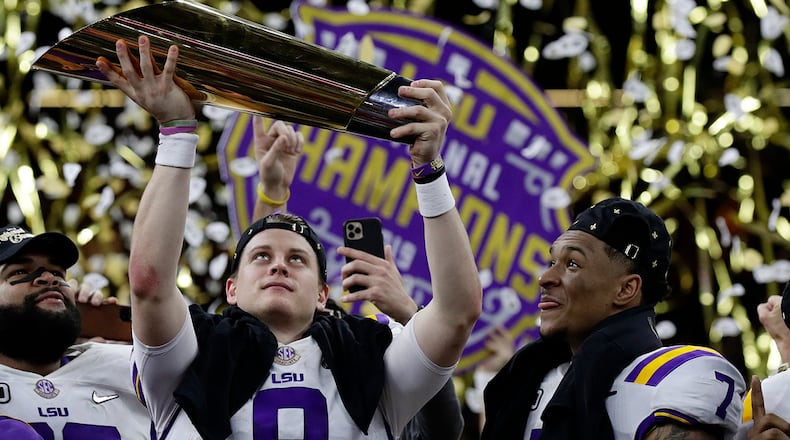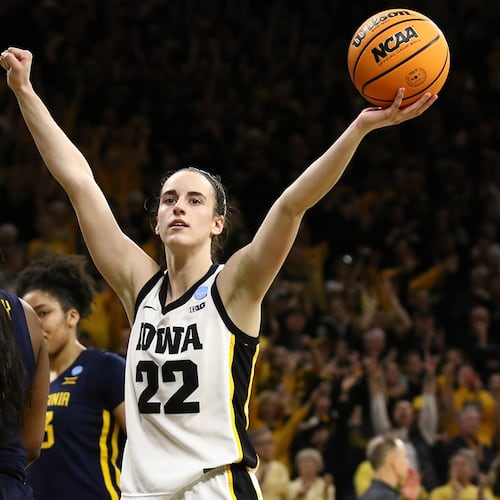We saw Joe Burrow in 2018, but we didn’t see this Joe Burrow. He left Ohio State for LSU, became the starting quarterback and helped the Tigers go a surprising 10-3. (Victories over top-10 teams Auburn, Georgia and Central Florida.) He had a nice season. But – apologies for repeating this factoid – he didn’t crack the assembled SEC media’s preseason all-conference team for 2019. Here’s who did:
First team: Tua Tagovailoa, Alabama. Second: Jake Fromm, Georgia. Third: Kellen Mond, Texas A&M.
As of July, the three top-rated quarterbacks on most draft boards were Tagovailoa, Fromm and Jacob Eason, of whom you've also heard. Burrow wasn't regarded as anything close to a first-rounder. On Thursday night, he became the No. 1 pick. We saw Joe Burrow coming, but we didn't see this Joe Burrow.
This Joe Burrow just authored the greatest single season by any collegiate quarterback. For all his gaudy numbers, these two dazzle: 60 touchdown passes, six interceptions. He averaged a touchdown pass every quarter. He averaged an interception every 10 quarters. If you saw him on TV, you caught only part of the effect. To see him in person was to be reduced to babbling. "This guy's unbelievable … Never throws a bad ball … WHOA!!! How the heck did he complete THAT?"
LSU beat seven top-10 teams en route to 15-0. Only two of those seven were played in Baton Rouge. Here were the five quarterbacks Burrow outplayed in significant road/neutral-site games: Sam Ehlinger, Texas; Tagovailoa; Fromm; Jalen Hurts, Oklahoma, and Trevor Lawrence, Clemson. (He also shredded A&M, with Mond, 50-7 in Tiger Stadium.)
The 2019 Heisman Trophy was supposed to belong to Tagovailoa or Lawrence. They finished 10th and seventh. Burrow won by an astonishing margin. If you added the voting totals for the second- through seventh-place finishers, their aggregate would still have finished second to him.
But enough about 2019. We’re into 2020, and Burrow is on to Cincinnati. There’s no reason to believe he can’t find professional success, though we know from history how difficult it is to find an NFL quarterback. (JaMarcus Russell, also of LSU, was the No. 1 pick in 2007; Tom Brady, not of LSU, went 199th in 2000.) If you saw Burrow in the past season, there was nothing not to like: He could complete every throw and elude most every rusher, and he did it against one of the toughest schedules on record.
That said, a tiny part of me wonders if, having just minted the gold standard of seasons, Burrow will ever again know a spot so sweet. The Bengals are 8-24 over the past two seasons. They haven’t broken .500 since 2015. They haven’t won a playoff game since Jan. 6, 1991. They’re coached by Zac Taylor, who’s 36 and who got the job largely because he’d been an assistant coach under Sean McVay, whose currency has since been devalued.
As an LSU junior, the same Burrow – but not the same, which is the point – finished 65th nationally in passing efficiency, 11th-best in the SEC. He had 16 touchdown passes in 13 games. The splendid receivers Justin Jefferson, Ja’Marr Chase and Terrace Marshall were in place, as was the back Clyde Edwards-Helaire, but the effect was nothing special. Which makes us ask, even after the wonders Burrow & Co. just worked, if the difference wasn’t Joe Brady.
At age 29, Brady was imported by Ed Orgeron from the NFL Saints to jazz up LSU’s passing game. His title was “passing game coordinator/wide receivers coach.” (Steve Ensminger remained offensive coordinator.) Such was the Brady Effect that LSU agreed to more than double his salary to $1 million, but he left to become the Carolina Panthers’ OC. The Bengals’ OC is Brian Callahan; the first edition of his offense finished 26th among the NFL’s 32 teams.
The trouble with quarterbacks taken No. 1 overall is that they join terrible teams. Jim Plunkett exited Stanford with a Heisman and a Rose Bowl win; in five years with New England, he didn’t preside over a winning season. He would win two Super Bowls as a Raider. Terry Bradshaw’s hold on the Steelers’ starting job wasn’t secure until Year 5, when he led them to the first of four Super wins in six years. Peyton Manning’s first Colts team finished 3-13. Troy Aikman’s record as a Dallas rookie starter was 0-11.
Those are four of the five quarterbacks to go No. 1 and win a Super Bowl. The other is Eli Manning, who forced a trade to the Giants after he was taken by the Chargers. And that’s the thing: When you’re taking a quarterback No. 1, you’re essentially saying, “This is the guy who can win us a Super Bowl.” Not all do. Steve Bartkowski didn’t. Vinny Testaverde didn’t. Drew Bledsoe didn’t. Tim Couch didn’t. Michael Vick didn’t. Matthew Stafford and Cam Newton haven’t yet.
There was no way the Bengals could pick anyone other than Burrow. He’s the best quarterback prospect since Andrew Luck, even if he didn’t seem such a big deal eight months ago. He plays the most important position, and he just played it at a level heretofore unseen. Heck, he’s even from Ohio. But the harmonic convergence that was LSU’s giddy season – Burrow + Brady + those receivers – isn’t apt to replicated in the Queen City anytime soon.
Having covered Burrow’s final three college games, I have nothing but raves. I do wonder, though, if we’ll be raving five years hence.
About the Author
The Latest
Featured



